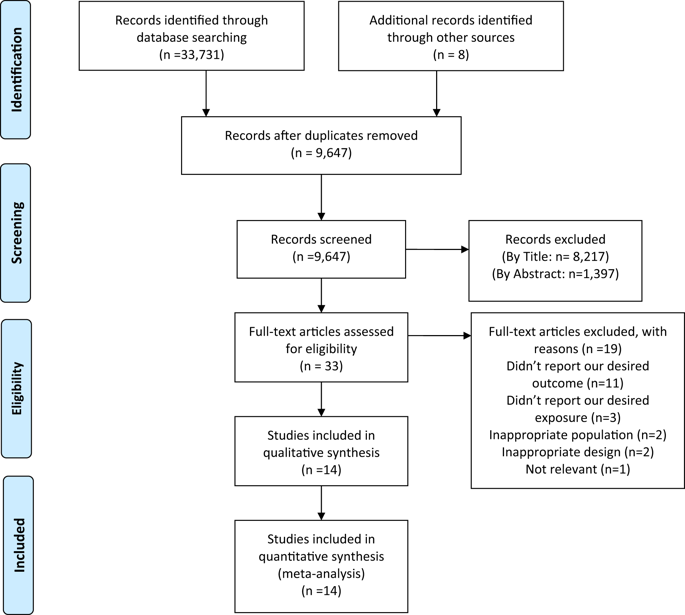当前位置:
X-MOL 学术
›
Int. J. Obesity
›
论文详情
Our official English website, www.x-mol.net, welcomes your feedback! (Note: you will need to create a separate account there.)
The effect of body mass index on sperm DNA fragmentation: a systematic review and meta-analysis.
International Journal of Obesity ( IF 4.9 ) Pub Date : 2020-01-16 , DOI: 10.1038/s41366-020-0524-8 Mahdi Sepidarkish 1 , Arezoo Maleki-Hajiagha 2 , Saman Maroufizadeh 3 , Mahroo Rezaeinejad 4 , Amir Almasi-Hashiani 5 , Maryam Razavi 6
International Journal of Obesity ( IF 4.9 ) Pub Date : 2020-01-16 , DOI: 10.1038/s41366-020-0524-8 Mahdi Sepidarkish 1 , Arezoo Maleki-Hajiagha 2 , Saman Maroufizadeh 3 , Mahroo Rezaeinejad 4 , Amir Almasi-Hashiani 5 , Maryam Razavi 6
Affiliation

|
BACKGROUND
Current evidence supports the association between the high sperm DNA fragmentation (SDF) and the poor fertilization rate following either natural conception or assisted reproductive techniques (ART). On the other hand, there are conflicting results regarding the decreased sperm DNA integrity in men with high body mass index (BMI).
OBJECTIVE
We aimed at the present systematic review and meta-analysis at evaluating the association between BMI and SDF.
METHODS
We searched databases of Medline, Embase, Scopus, and Web of Science up to May 2019, to identify observational studies that assessed the associations between BMI and SDF. BMI was classified, according to the standard BMI classifications, into six categories including underweight (<18.5), normal weight (18.5-24.99), overweight (25-29.99), class I obesity (30-34.99), class II obesity (35-39.99), and class III obesity (≥40). Standardized mean differences (SMDs) and 95% confidence intervals (CIs) of SDF were calculated by using a random-effects model for BMI categories.
RESULTS
The initial extensive literature search yielded 33,739 potentially relevant articles (3,917 from Medline, 781 from Embase, 12,685 from Scopus, and 9,348 from Web of Science). Fourteen studies (nine cross-sectional, four cohort, and one case-control studies), with a total number of 8,255 participants, were included in the meta-analysis. Finally, three studies reported higher SDF levels in obese men (BMI = 30-34.99) compared with normal-weight men (BMI < 25) (SMD: 0.23, 95% CI: 0.01, 0.46, P = 0.05, I2 = 0%), but there was no difference between other categories.
CONCLUSIONS
There is insufficient data to demonstrate a positive association between BMI and SDF. Our findings provide a rationale for conducting further cohort studies for evaluation of the association between BMI and SDF, considering potential confounders.
中文翻译:

体重指数对精子DNA片段化的影响:系统评价和荟萃分析。
背景技术目前的证据支持在自然受孕或辅助生殖技术(ART)后,高精子DNA片段化(SDF)与受精率差之间的联系。另一方面,关于高体重指数(BMI)的男性精子DNA完整性下降的结果存在矛盾。目的我们旨在目前的系统评价和荟萃分析,以评估BMI和SDF之间的关联。方法我们搜索了截至2019年5月的Medline,Embase,Scopus和Web of Science数据库,以鉴定评估BMI和SDF之间关联的观察性研究。根据标准BMI分类,BMI分为六类,包括体重过轻(<18.5),正常体重(18.5-24.99),超重(25-29.99),I类肥胖(30-34.99),II类肥胖(35-39.99)和III类肥胖(≥40)。通过使用BMI类别的随机效应模型,计算SDF的标准均值差(SMD)和95%置信区间(CI)。结果初步的广泛文献搜索产生了33,739篇可能相关的文章(Medline的3,917篇,Embase的781篇,Scopus的12,685篇,Web of Science的9,348篇)。荟萃分析包括十四项研究(九项横断面研究,四项队列研究和一项病例对照研究),总共有8,255名参与者。最后,三项研究报告称,肥胖男子(BMI = 30-34.99)与正常体重男子(BMI <25)相比,SDF水平更高(SMD:0.23,95%CI:0.01,0.46,P = 0.05,I2 = 0% ),但其他类别之间没有区别。结论没有足够的数据证明BMI和SDF之间存在正相关。我们的发现为进行进一步的队列研究以评估BMI和SDF之间的关联性提供了理论依据,同时考虑了潜在的混杂因素。
更新日期:2020-01-16
中文翻译:

体重指数对精子DNA片段化的影响:系统评价和荟萃分析。
背景技术目前的证据支持在自然受孕或辅助生殖技术(ART)后,高精子DNA片段化(SDF)与受精率差之间的联系。另一方面,关于高体重指数(BMI)的男性精子DNA完整性下降的结果存在矛盾。目的我们旨在目前的系统评价和荟萃分析,以评估BMI和SDF之间的关联。方法我们搜索了截至2019年5月的Medline,Embase,Scopus和Web of Science数据库,以鉴定评估BMI和SDF之间关联的观察性研究。根据标准BMI分类,BMI分为六类,包括体重过轻(<18.5),正常体重(18.5-24.99),超重(25-29.99),I类肥胖(30-34.99),II类肥胖(35-39.99)和III类肥胖(≥40)。通过使用BMI类别的随机效应模型,计算SDF的标准均值差(SMD)和95%置信区间(CI)。结果初步的广泛文献搜索产生了33,739篇可能相关的文章(Medline的3,917篇,Embase的781篇,Scopus的12,685篇,Web of Science的9,348篇)。荟萃分析包括十四项研究(九项横断面研究,四项队列研究和一项病例对照研究),总共有8,255名参与者。最后,三项研究报告称,肥胖男子(BMI = 30-34.99)与正常体重男子(BMI <25)相比,SDF水平更高(SMD:0.23,95%CI:0.01,0.46,P = 0.05,I2 = 0% ),但其他类别之间没有区别。结论没有足够的数据证明BMI和SDF之间存在正相关。我们的发现为进行进一步的队列研究以评估BMI和SDF之间的关联性提供了理论依据,同时考虑了潜在的混杂因素。



























 京公网安备 11010802027423号
京公网安备 11010802027423号